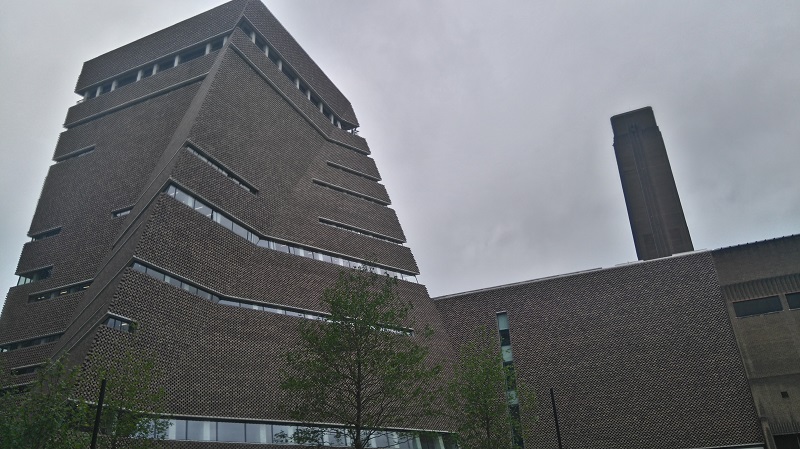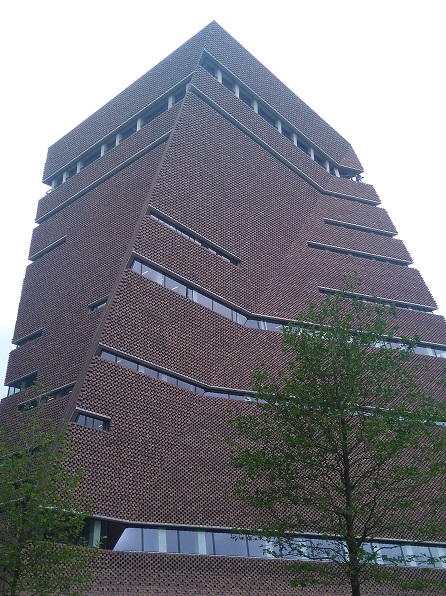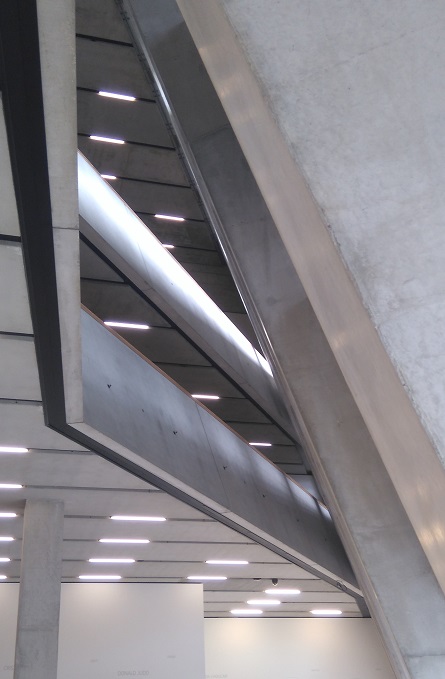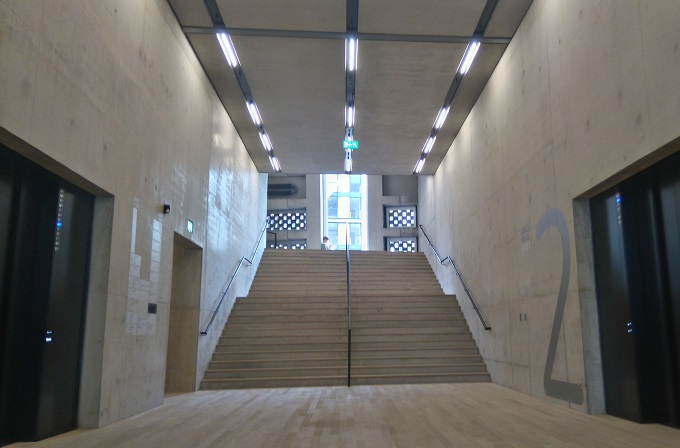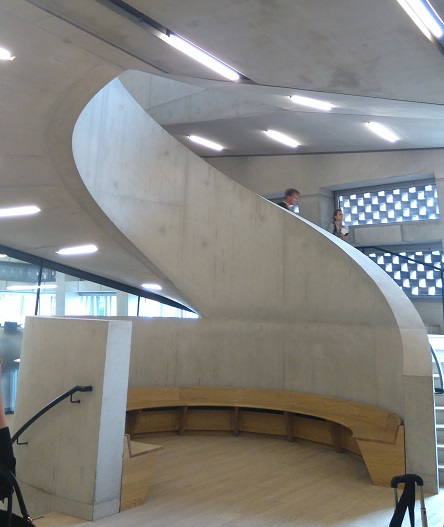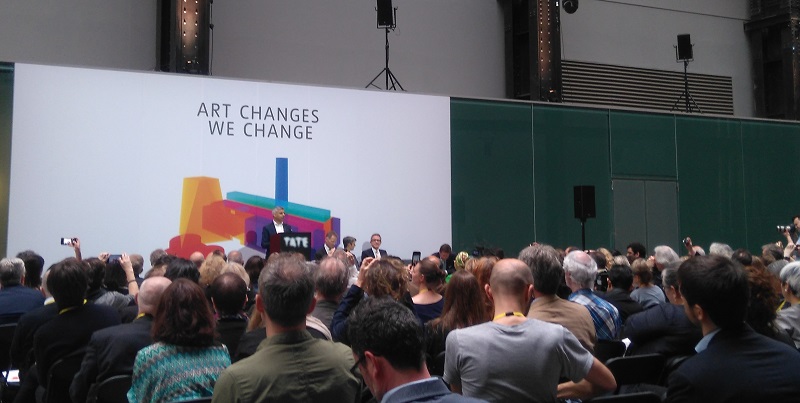Switch House, Tate Modern
Contents |
[edit] About the Switch House
In June 2016, Designing Buildings Wiki attended a preview of the new extension of the Tate Modern, located on the south bank of London’s Thames. The Switch House opened 16 years after the former Bankside Power Station was reopened to become the world’s most popular museum of modern and contemporary art.
Designed by internationally-renowned architects Herzog & de Meuron, the extension adds 60% more space to be used for live art, installations and film. It has been touted as Britain’s most important new cultural building for almost two decades.
The cylindrical underground Tanks, each of which measures more than 30 m across, serve as the foundations of the 10-storey Switch House building, which is a sharp-angled pyramid-like structure with the power station’s brickwork reinterpreted in a perforated lattice cladding of 336,000 bricks.
Window openings in the façade progress from thin and vertical to long and horizontal as their height increases, allowing light to filter in during the day and ot glow outwards during the evening.
The interior is formed almost entirely using exposed concrete, with sweeping staircases and unusual angles that provide an impression of spaciousness without appearing cavernous.
A public terrace on the 10th floor offers 360-degree panoramic views of London, and a new bridge spanning the Turbine Hall joins the existing galleries in the Boiler House with the new galleries in the Switch House.
Sustainability is at the heart of the design, with a high thermal mass, natural ventilation, solar panels and newly-created green spaces.
At the launch, the new Mayor of London Sadiq Khan, described the Tate as “a modern museum for the 21st century”. He said that for too long culture had been a ‘nice to have’ and that it would now be at the core of his administration. He touched on plans to introduce Creative Enterprise Zones where creative artists can live and work affordably instead of being priced out of the city.
Perhaps hinting at the upcoming EU referendum, Culture Minister Ed Vaizey, said the museum and its global collection served as a statement about a “confident Britain that looks out on the world”.
[edit] Controversy
Since its completion, the Switch House viewing platform has been mired in some controversy as occupants of the neighbouring Neo Bankside have complained about their loss of privacy.
In April 2017, residents of the RSHP-designed Neo Bankside began a legal bid trying to force the shutting down of part of the viewing platform. Five residents lodged papers at the High Court seeking an injunction. They claim that the Tate Modern is in breach of their human rights due to 'near constant surveillance' from visitors on the platform who are able to look directly into their apartments.
The papers claim that, 'the defendants’ use of … part of its viewing platform is unreasonably interfering with the claimants’ enjoyment of their flats, so as to be a nuisance', and say that the visual intrusion '...does not provide a safe or satisfactory home environment for young children.'
The claim highlights the fact that visitors often use binoculars and take photographs and footage of their homes, before posting them on social media.
Residents have called for the terrace to be cordoned off, or for a screen to be built at their expense along the viewing platform. However, the Tate Modern, while putting up notices asking visitors to 'respect the privacy' of their neighbours, were not willing to restrict access to the platform.
Neo Bankside won planning permission in June 2007 and the scheme started on site two years later and finished in 2012.
The original Tate Modern extension was permitted in December 2008 and included a rooftop terrace in its plans. A revised proposal including a brick façade and the viewing gallery was permitted in May 2009 as work began on the adjacent Neo Bankside. It is understood that no objections were raised to the proposed terrace at the time.
For more information, see Tate Modern.
[edit] Find out more
[edit] Related articles on Designing Buildings Wiki
Featured articles and news
Infrastructure that connect the physical and digital domains.
Harnessing robotics and AI in challenging environments
The key to nuclear decommissioning and fusion engineering.
BSRIA announces Lisa Ashworth as new CEO
Tasked with furthering BSRIA’s impressive growth ambitions.
Public buildings get half a million energy efficiency boost
£557 million to switch to cleaner heating and save on energy.
CIOB launches pre-election manifesto
Outlining potential future policies for the next government.
Grenfell Tower Inquiry announcement
Phase 2 hearings come to a close and the final report due in September.
Progress from Parts L, F and O: A whitepaper, one year on.
A replicated study to understand the opinion of practitioners.
ECA announces new president 2024
Electrical engineer and business leader Stuart Smith.
A distinct type of countryside that should be celebrated.
Should Part O be extended to existing buildings?
EAC brands heatwave adaptation a missed opportunity.
Definition of Statutory in workplace and facilities management
Established by IWFM, BESA, CIBSE and BSRIA.
Tackling the transition from traditional heating systems
59% lack the necessary information and confidence to switch.
The general election and the construction industry
As PM, Rishi Sunak announces July 4 date for an election.
Eco apprenticeships continue help grow green workforce
A year after being recognised at the King's coronation.
Permitted development rights for agricultural buildings
The changes coming into effect as of May 21, 2024.







